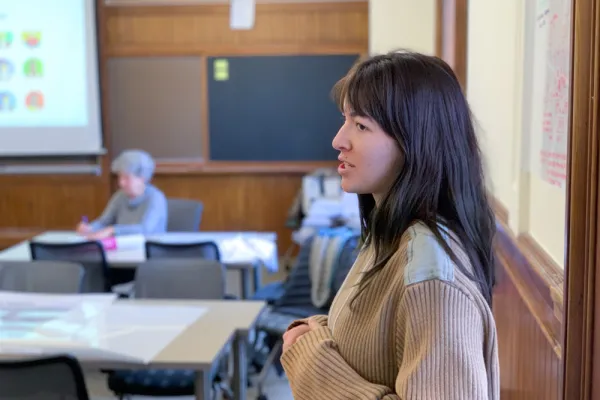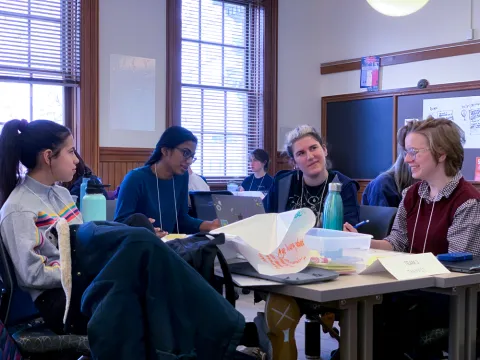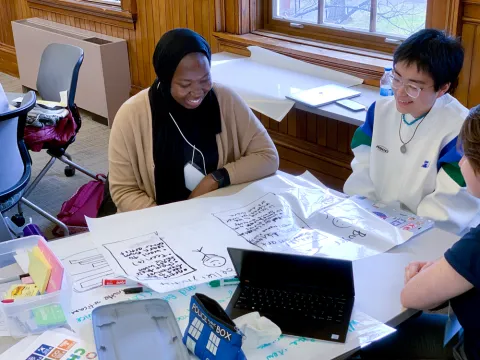Interterm Immersive
Research & Inquiry

Published January 29, 2020
In her Interterm classes this January, Paige Moore ’20 made use of a compass, a napkin and a canvas.
The Innovators Compass, the Idea Napkin and the Business Model Canvas, that is—all strategic tools used in design thinking and entrepreneurship.
This year, students were offered a three-week sequence of classes in those subjects over Interterm. Smithies could enroll in one or more of the team-based classes: “Introduction to Human Centered Design,” “Introduction to Entrepreneurship” and “Entrepreneurship in Action.”
Moore, who is majoring in neuroscience, signed up for all three. “In my last year at Smith, I wanted to spend some time figuring out what I’m called to do,” she said. “I really enjoyed the process and the interactivity.”
A New Sequence
The process involved using United Nations Sustainable Development Goals as inspiration for projects aimed at meeting critical societal needs. Working in teams, students designed solutions, focusing in the design thinking course on creating human-centered models, and in the entrepreneurship courses on how to market new products and services.
The aim of the sequence was “to give students the opportunity to look at complex problems and develop an entrepreneurial mindset,” said course instructor Monica Dean, director of the Jill Ker Conway Innovation and Entrepreneurship Center.
Emily Norton, director of Smith’s Design Thinking Initiative, said offering courses as a series helped students develop core skills using the resources of both the Design Thinking Initiative and the Conway Center.
“This was an opportunity to build on and complement each other’s work,” she said. “It’s an example of how our centers are starting to integrate more intentionally.”
A Compass for Ideas
In Norton’s design thinking class, students used the Innovators Compass to move ideas for improving life at Smith, from the “outlandish” to the doable. The compass tracks a path that starts with identifying people who could be served by a design, then progresses through observation, refinement and testing of prototypes.
As the week went on, the whiteboard walls of Capen Annex grew covered with pastel-colored Post-it notes, as project designs ranging from student self-care kits to a new speaker series about life after Smith took shape.

Those ideas didn’t stay in the realm of theory. Students gathered data from interviews with campus community members and tested their designs with stakeholders in Student Affairs, Health Services and the Lazarus Center for Career Development.
Bella Levavi ’22, whose team designed a new community-building social network for Smith houses, said the course helped her “gain skills I wouldn’t have gotten otherwise.”
“Just working in a group is a skill,” she added. “That’s something I am definitely going to use in my other courses.”
The Napkin and the Canvas
Midway through the first entrepreneurship course, the classroom in Seelye was humming with the sounds of teamwork, as students prepared to present initial designs for projects such as flexible clothing for trans women, “baby boxes” for new parents, and truck-based toilets to help people stuck in traffic jams in overcrowded cities around the globe.
Using the Idea Napkin and Business Model Canvas tools for viable ventures, students worked to create effective descriptions of their products and identify target markets.
They also got helpful feedback from course instructors Monica Dean and Fadia Hasan, a lecturer in English language and literature and founder of an international youth nonprofit focused on sustainability.
“You’ve done a good job of identifying a clear demographic,” Hasan told the “Drive and Flush” portable toilet project team following their presentation. “How could you make it cost effective to reach more people?”

For Luca Jacodine ’20, the main takeaway was that defining an audience “can make whatever argument you are making much stronger and more persuasive.”
Having worked at the Conway Center as a peer educator, Jacodine was eager for a chance to practice entrepreneurial thinking, and the Interterm sequence allowed her to do just that.
“I really appreciated the application of complex concepts to real-world situations and the freedom to try out those concepts ourselves,” she said. “The methods we learned can apply to work at Smith—and even beyond.”